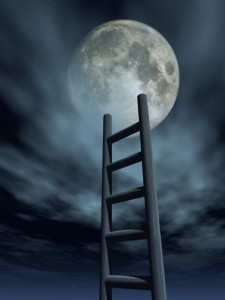The History of Histories (Part 7)
By Asher Crispe: November 7, 2012: Category Inspirations, Quest of the Question
Dual Deeds and Free Agents
 The fork of subversion approaches with four prongs. While any one of them is sufficient to impale our sense of holistic existence (and therefore create gaps, holes, voids, zones of absence and privations), inflicted together they break up our perception of reality, driving a wedge between creature and Creator. More importantly, an invisible string stretches from the trigger of one form of subversion to the trigger of the next, setting off a chain reaction that destabilizes our relationship with the meaning of Being and the purpose of Creation. Getting all the strewn about contents of our experience back together and reassembling them (the ingathering of the exiles) takes time–time which sets in motion the march of history. Historical time then amounts to a process of restoration and enhancement of what was lost. What could no longer exist all at once in immediacy and proximity now belongs to an implicate order of becoming through the experience of years, months, weeks, and days.
The fork of subversion approaches with four prongs. While any one of them is sufficient to impale our sense of holistic existence (and therefore create gaps, holes, voids, zones of absence and privations), inflicted together they break up our perception of reality, driving a wedge between creature and Creator. More importantly, an invisible string stretches from the trigger of one form of subversion to the trigger of the next, setting off a chain reaction that destabilizes our relationship with the meaning of Being and the purpose of Creation. Getting all the strewn about contents of our experience back together and reassembling them (the ingathering of the exiles) takes time–time which sets in motion the march of history. Historical time then amounts to a process of restoration and enhancement of what was lost. What could no longer exist all at once in immediacy and proximity now belongs to an implicate order of becoming through the experience of years, months, weeks, and days.
Since, we have already addressed the will of wills that permits a counter-will (a challenge to the overarching Divine desire to have a dwelling place below in the mundane reality of our physical world) it follows that the most profound transformation occurs when we counter our counter-will. Solutions are hidden in the problems themselves. Walls turn into windows. While the initial conflict is real and cannot be under estimated, even the antithetical will can be reformed–the enemy turns friendly and channels that same force of opposition into active assistance.
Corresponding to the four letters of the Divine name (Havayah) which means ‘Being’ (whereby each letter [Yud-Hei-Vav-Hei ] represents another mode of Being), the placement of each of the paradigmatic examples of subversion underscores the nested structure of these oppositions of the Divine will. The flaws and defects of each level contaminate the level directly below it. The lower down the ladder of the name, the more particularized the phenomenon becomes, while the higher up we go, the more universalized the phenomenon.
Here are the first two starting from the bottom up:
1) Adam (and Chava/Eve) eating from the Tree of Knowledge
In this example, we encounter an individual whose will runs counter to the Divine will that commanded us to not eat from the Tree. By eating from the Tree we suddenly became self-conscious. My sense of self can quickly balloon into the tough skin of ego, the abrasive barrier that keeps the world out while locking me in. The lack produced resulted in the unleashing of entropy (death) on the world and more specifically on the individual human being. A solid ego that comes from a self-conscious self is a consequence of our interest in how we look, what we are thinking and how we are feeling. I am distracted by my sense of self. I am self-concerned which siphons off my attention away from others (both Divine and human).
This levels pertains to the second letter Hei in the Divine name which itself corresponds to Malchut or ‘Kingship.’ I am now not thinking of the governance of the Creator or His will. Instead I have shifted focus away from Him towards myself. What kind of impact am I having on others? How am I being perceived? My ‘Kingdom’ is my self-image that I try on for size. I call attention–mostly my attention–to myself. In this manner, my will rules. My words and actions are now vehicles for expressing myself and not necessary ‘home’ to Divinity. From the standpoint of human consciousness: where is the Creator to dwell? Not within me. I am here. I house myself. There is no room for double occupancy. Thus, the Divine Presence is exiled to the exterior. Divinity becomes perceived as something that approaches me from the outside. Electrified individuality creates a force of resistance to the touch of Divine influence, effectively bringing about the exile of the self with the self.
2) The Diminishing of the Moon
While the agency of mankind was at work in the eating episode, we can hardly be blamed for this other defect in Creation in that the Midrash records it has having happened on Day Four of Creation prior to the arrival of the human. On that day the two great luminaries, the sun and the moon, were strategically placed. As the story goes, the moon complained saying ‘how can two kings make use of the same crown?’ God’s response was to diminish the moon thereby making it the inferior of the two. Ironically, this Divine act is likened in the rabbinic tradition to God sinning against Himself. He did it and must take responsibility for it. How can He atone to Himself as it were?
One explanation for this bizarre episode issues from the writing of Reb Issac of Homil, one of the great intellectual figures of the Chassidic tradition. In his work Shnei Meorot (Two Luminaries), he presents this ‘punishment’ of diminished stature of the moon in very different terms from those that we might gather from a surface reading of this midrashic tale. He asserts that it was not that the physical size of the moon was altered. Nor did the moon have any light of its own before this shift. Rather, the moon was originally transparent. It was a perfect reflector of the sun. All of the light that it collected was able to shine through. For this to happen, the moon would have had to appear always full.
Drilling down even further, Chassidic interpretations liken the sun-moon dynamic to the source of light or an experience as it is rooted in myself (like an emotion that burns in the heart like the sun) and the manner in which that experience can be reflected in various forms of self-expression or in the way in which another person would pick up on them (the moon). If I could relay my feelings to the fullest and have them totally reflected then the moon would be illuminated and illuminating all of the time. Furthermore, the moon would share the same intent as the sun. By intent we are alluding to the crown which is itself a symbol for will in Kabbalah. Sharing one’s crown between two kings, would be like two different operators holding onto a common will. This could be phrased as simply as ‘I said what I wanted to say and you understood what I meant by it.’ As for our modeling of the Divine name, in relation to the final Hei, this level relates to the Vav which represents the emotions or middot.
 The problem arises when the moon or reflector loses confidence and goes dark. The reality is the intensity of what I feel cannot be so easily transmitted. Perhaps if it is toned down a bit I will be able to get some of my emotive experience across? Likewise, I may feel like my message cannot be received unless it is watered down. Better to not reveal everything in its full intensity. Thus, the phases of the moon are the locks and levies for controlling the strength and directness of the signal that is communicated to others. The true character of the sun must be filtered, yet in doing so something is lost. We lack the complete experience. Language is far from being transparent. At times we communicate more and at times less. On rare occasions, we don’t seem to communicate anything at all for the moon has temporarily disappeared.
The problem arises when the moon or reflector loses confidence and goes dark. The reality is the intensity of what I feel cannot be so easily transmitted. Perhaps if it is toned down a bit I will be able to get some of my emotive experience across? Likewise, I may feel like my message cannot be received unless it is watered down. Better to not reveal everything in its full intensity. Thus, the phases of the moon are the locks and levies for controlling the strength and directness of the signal that is communicated to others. The true character of the sun must be filtered, yet in doing so something is lost. We lack the complete experience. Language is far from being transparent. At times we communicate more and at times less. On rare occasions, we don’t seem to communicate anything at all for the moon has temporarily disappeared.
The problem of self-consciousness that is bound up with the eating from the Tree of Knowledge may then be said to sit against the backdrop of the diminishment of the moon. The challenge to the Divine will came earlier from this ‘imperfection’ of exchanges between transmitter and receiver, in the challenge of sharing feelings. So maybe it’s not completely Adam’s fault after all. The awe inspired act of God acts up. ‘Acting up’ means a lower rung on the ladder suffered on account of a defect on a higher rung. Stated otherwise, the higher level was the cause of the lower level. The ambiguity of shared experience and feeling created by this lesser moon paved the way for my getting lost in my self. Self-absorption is symptomatic of the ruin of communicable experiences.
The third and forth transgressive examples will be spelled out in Part Eight.
http://www.interinclusion.org/inspirations/the-history-of-histories-part-8/
http://www.interinclusion.org/inspirations/the-history-of-histories-part-6/























;)
;)
;)
;)
;)
;)
;)
;)
;)
;)
